Oracle Fusion HCM Flex Fields training course
Oracle Fusion HCM Key Flex Fields
Oracle Fusion HCM and its core flex fields which play a crucial role in enabling organisations to store additional data associated with business objects.
In Oracle Fusion HCM, we use various types of flex fields to capture and organise this information effectively.
Oracle Fusion HCM includes key, descriptive and extensible flex fields to meet enterprise data storage needs in an organised and flexible manner.
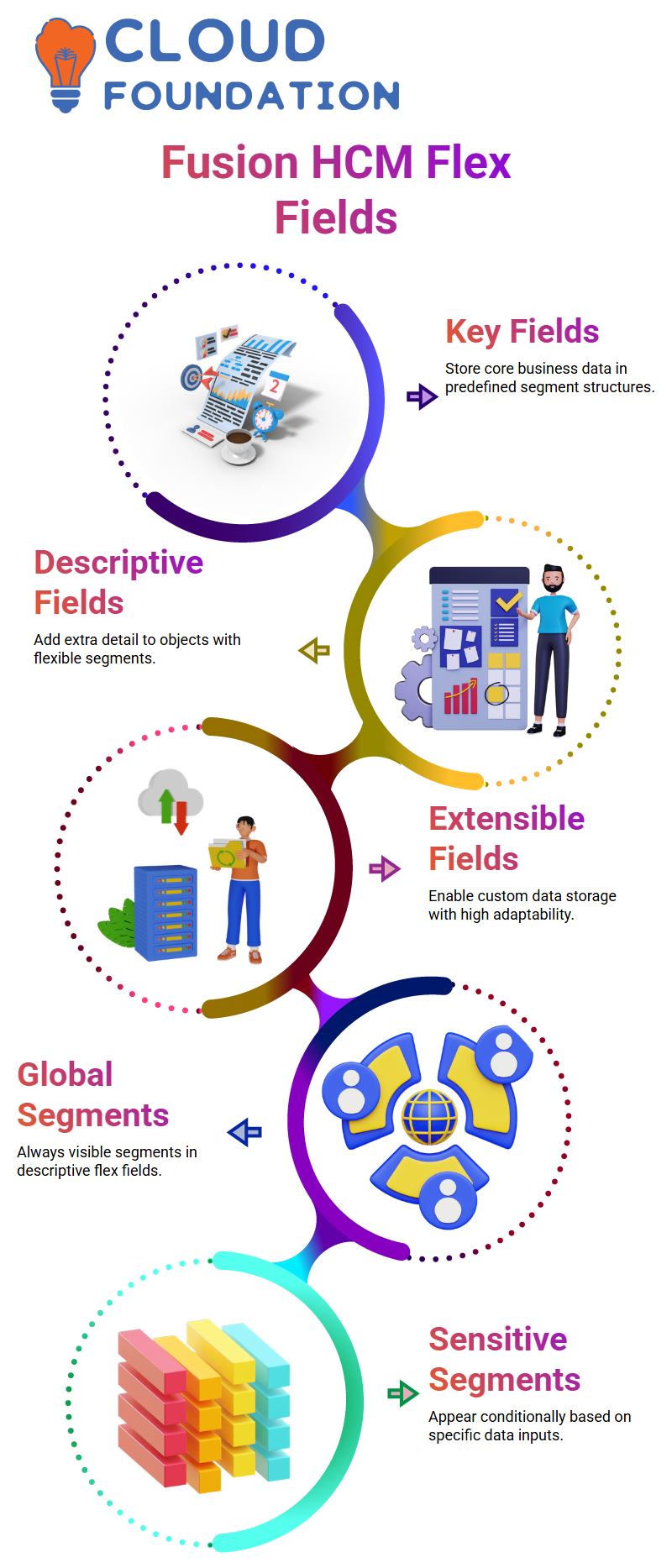
Key flex fields serve as placeholders for critical business information, while descriptive fields add extra details using predefined segments that enhance flexibility.
Types of Oracle Fusion HCM Flex Fields
Oracle Fusion HCM features two types of segments in descriptive flex fields–global and sensitive segments.
While global segments are always present, sensitive ones only appear based on specific conditions within the data input. Understanding these segments allows us to customise data input efficiently.
Oracle Fusion HCM’s extensible flex fields are similar to descriptive flex fields in that they store information separately in distinct database records, providing improved adaptability and configuration.
Attribute subgroups and complex value storage are two additional features that add customizability and adaptability for these highly adaptable fields.
Oracle Fusion HCM Key Flex Fields for Cost Allocation
Oracle Fusion HCM key flex fields are typically utilised for cost allocation and grouping employees into specific categories. Cost allocation key flex fields help organisations effectively categorise payroll expenses while simultaneously maintaining accurate financial tracking.
People group flex fields enable organisations to quickly identify groups based on employment structures, simplifying workforce management.
Furthermore, these key flex fields serve as the cornerstone for efficient payroll processing in Oracle Fusion HCM.
Implementing Oracle Fusion HCM Key Flex Fields
Implementing key flex fields within Oracle Fusion HCM requires setting the appropriate segments and value sets, which enable businesses to structure data according to their specific enterprise requirements.
Establishing new flex field structures involves setting segment codes, names, prompts and display settings according to an organisation’s payroll and workforce management needs.
Oracle Fusion HCM makes this task straightforward for organisations looking to customise these elements to match up with payroll management practices and requirements.
Deploying Oracle Fusion HCM Flex Fields
Once key flex fields have been configured in Oracle Fusion HCM, they must be deployed for them to remain usable in applications. Otherwise, they will remain inactive and cannot be utilised within them.
Organisations seeking to utilise Oracle Fusion HCM key flex fields must follow a structured implementation project approach to install them successfully within their systems and enhance enterprise operations.
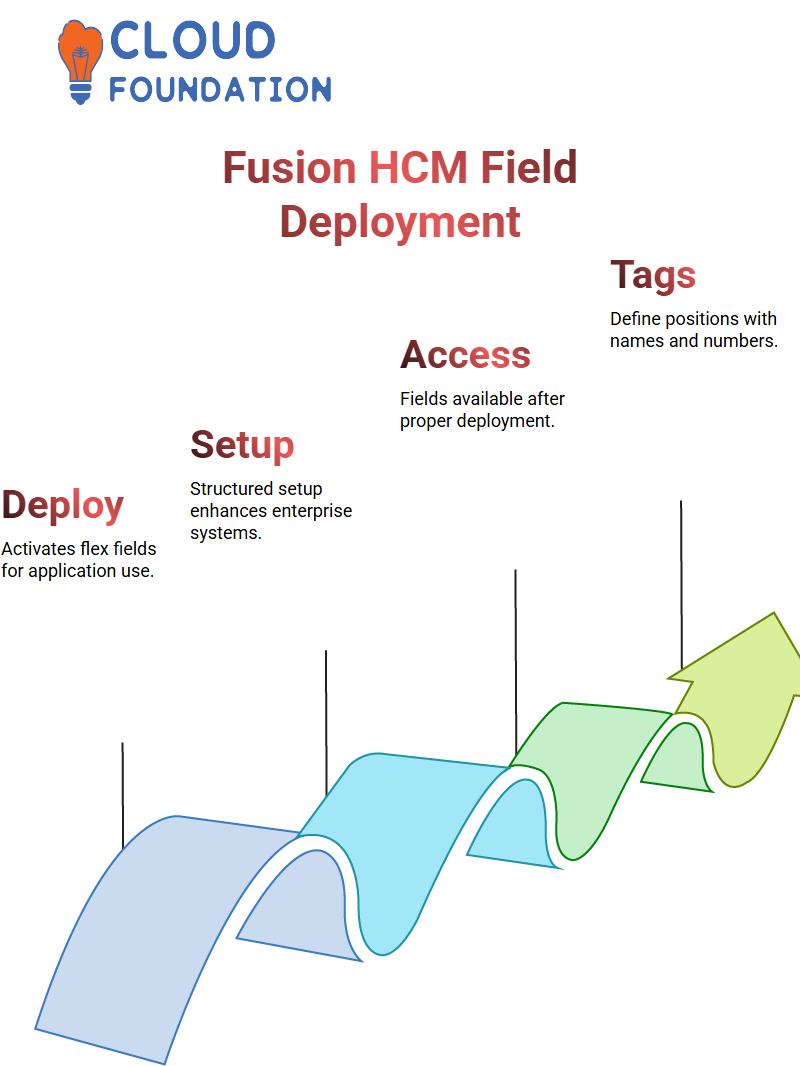
Once deployed, these flex fields become accessible within them and contribute towards streamlining operational activities.
Enterprise-Level Attributes in Oracle Fusion HCM
Enterprise attributes play a crucial role in shaping workforce structures within Oracle Fusion HCM. Every position comes complete with its name and number to simplify management and facilitate quick and effortless identification.
Each position in our workforce has been assigned a unique name and number to ensure efficient tracking across different business units.
Oracle Fusion HCM Positions
Oracle Fusion HCM makes managing job positions effortless. To create new positions, we specify details such as business unit, department, job title, and location.

For instance, ‘US Consultant’ could be associated with a healthcare unit. The flexibility provided by this software makes managing positions effortless.
Position Structures in Oracle Fusion HCM
Oracle Fusion HCM clarifies organisational management through well-defined position structures and tree views of our position trees, providing insights into the organisation and linkages within hierarchies.
By viewing structured representations, one can gain insights into how positions are organised within hierarchies. With clear, viewable structures of data representations from position trees created with Oracle Fusion HCM, we gain greater insights.
Position Trees in Oracle Fusion HCM
Oracle Fusion HCM’s critical element for position trees is to define nodes and add them logically to a tree structure to ensure visibility when traversing the organisational hierarchy.
Oracle Fusion HCM enables users to distinguish between parent and child positions, making role assignment straightforward. If multiple roles need to be assigned simultaneously, we must ensure they align correctly.
Positioning trees within Oracle Fusion HCM enables us to visualise job structures within an organisation more effectively.
By creating one and attaching relevant positions at various nodes of the hierarchy, position trees help simplify reporting and decision-making in Oracle Fusion HCM.
Oracle Fusion HCM Trees and Hierarchies
Oracle Fusion HCM offers an innovative approach to administering organisational structures, with position trees, department trees, and organisation trees operating seamlessly together. We examined their roles within a hierarchy.
Position trees each role in an organisation connects to an organisational hierarchy through parent-child relationships that illustrate parent-child relations.
Oracle Fusion HCM makes this easy to see visually, helping HR professionals structure teams more efficiently.
Department and Organisation Trees in Oracle Fusion HCM
Oracle Fusion HCM’s structure relies heavily on department and organisation trees. A department can exist within any organisation, ranging from banking to manufacturing.
These classifications help define relationships within an organisation and improve workforce management.
Oracle Fusion HCM enables users to configure organisation trees with predefined nodes for optimal efficiency within their system.
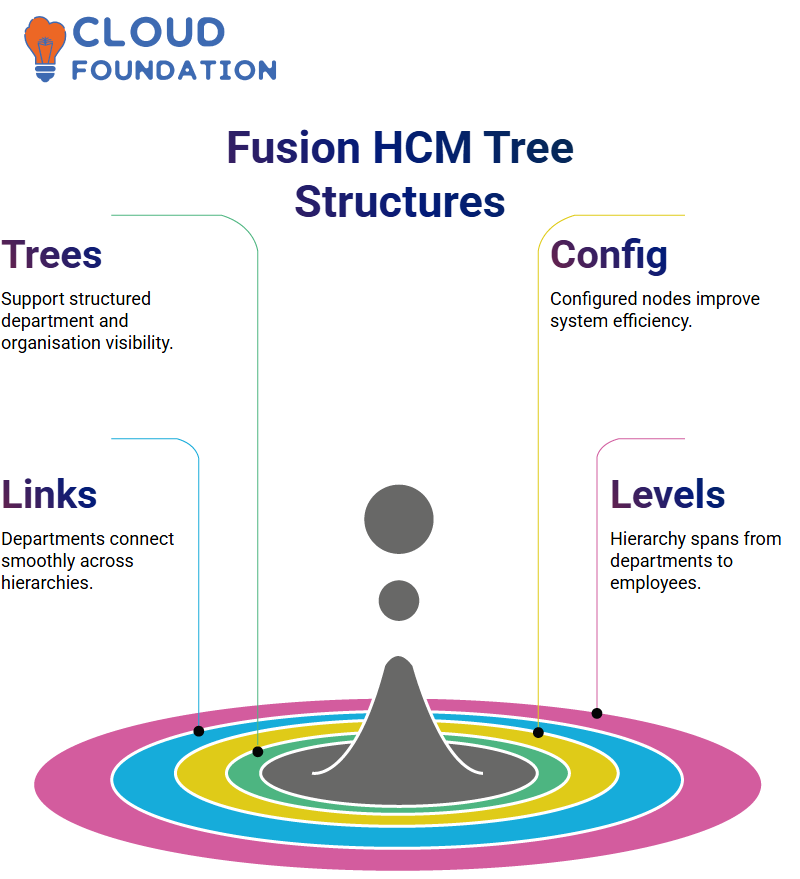
Each hierarchy follows an orderly path to ensure that departments link effectively across the organisation.
Organisational Hierarchies in Oracle Fusion HCM
Oracle Fusion HCM’s top-level classification feature creates a structured hierarchy for an organisation’s top classifications, from departments and security profiles, down to individual employees and departments.
Oracle offers powerful features designed to streamline operational efficiency for both of these features.
Oracle Fusion HCM’s workforce management functionality enables efficient workforce administration while offering visibility at every level of management.
By configuring organisation trees, departments, and position structures with Oracle Fusion HCM, organisations ensure efficient management at every level and visibility across every layer.
Hierarchies in Oracle Fusion HCM
Oracle Fusion HCM allows us to structure our organisation using position hierarchies.
At the top is our CEO, followed by executives, managers, and department heads.
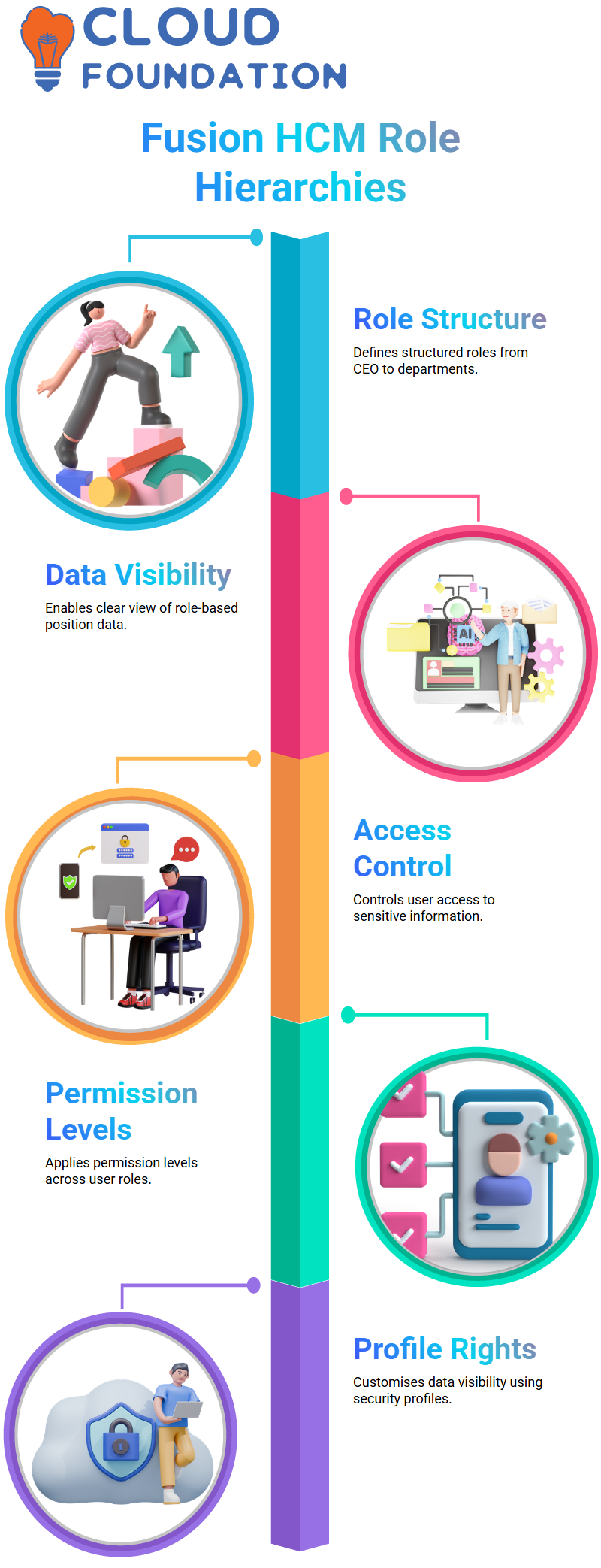
Each level provides smooth access and visibility of position-related data within Oracle Fusion HCM.
Security Profiles in Oracle Fusion HCM
Oracle Fusion HCM Security profiles enable organisations to restrict access to sensitive employee and position data by assigning security levels at multiple tiers to users based on their roles, thereby maintaining data confidentiality while enhancing operational efficiency.
Oracle Fusion HCM’s security profile setup enables organisations to control what information users can access, allowing hierarchies to follow specific permission levels to ensure data visibility remains managed.
Oracle Fusion HCM security profiles enable organisations to define access rights while seamlessly incorporating department and organisation trees. We explored this topic in more detail here.
Position Changes in Oracle Fusion HCM
Oracle Fusion HCM makes changing positions simple. When an employee moves to a new role or location, we search their current role and location before initiating a change request and updating the relevant details accordingly.
Oracle Fusion HCM ensures that all shifts are efficiently tracked and managed, providing an up-to-date organisational record of your position changes.
Budget Considerations in Oracle Fusion HCM
Budget allocation plays a critical role when assigning positions using Oracle Fusion HCM.
We define whether each role requires a single income source or is shared among multiple employees; using our software ensures that salaries and budget allocations align with organisational needs.
Promoting an Employee in Oracle Fusion HCM
Promotion in Oracle Fusion HCM can be an integral component of career advancement.
To facilitate this, the process begins by identifying an employee for promotion and choosing their new position, with factors such as performance, tenure, and internal evaluations all playing an integral part.
Once an employee receives a promotion, changes will be reflected in their employee records, including updated position details, job title changes, and responsibilities.
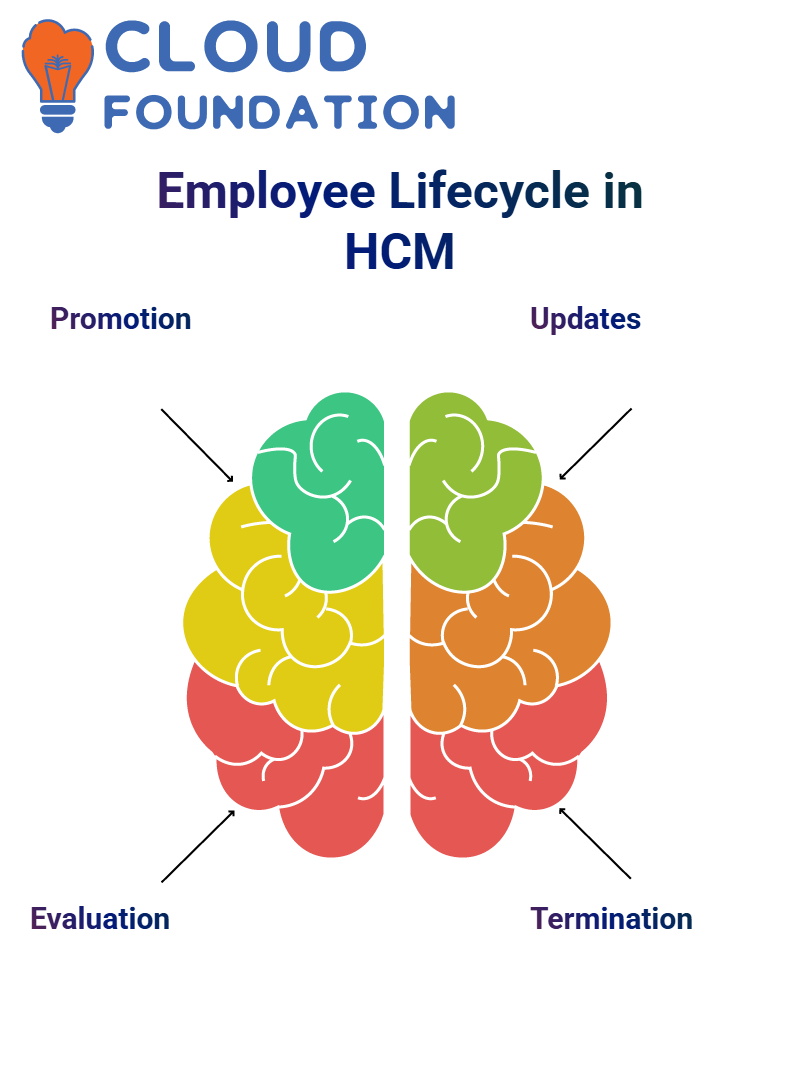 Oracle Fusion HCM facilitates this transition smoothly by ensuring that all necessary approvals and workflows are followed correctly.
Oracle Fusion HCM facilitates this transition smoothly by ensuring that all necessary approvals and workflows are followed correctly.
Employee Termination in Oracle Fusion HCM
Terminating employees using Oracle Fusion HCM requires an organised process.
From resignation to involuntary terminations, this system makes documenting and carrying out terminations seamless the effective date plays a crucial role.
At any point during the termination process, we can give reasons such as career advancement or better opportunities as grounds for termination.
Oracle Fusion HCM ensures that access rights are modified accordingly to prevent post-termination unauthorised use and facilitates rehiring former employees through an organised workflow process.
Oracle Fusion HCM Payroll Transfers
Accuracy in employee compensation relies on efficiently handling payroll transfers in Oracle Fusion HCM.
By automating payroll data transfer processes with Oracle Fusion HCM, transfers become seamless, ensuring the accurate allocation of overtime pay and accurate salary calculations.
Global Transfers with Oracle Fusion HCM
Oracle Fusion HCM streamlines global transfers by accurately recording changes to job assignments, managers, and salaries.

When an employee transfers to another legal entity, Oracle Fusion HCM facilitates any necessary modifications efficiently and effectively.
Data Extracts in Oracle Fusion HCM
Data extraction within Oracle Fusion HCM. Extracts play a crucial role in connecting to external systems and generating reports efficiently.
Oracle Fusion HCM’s extract feature enables the effortless retrieval of large volumes of employee details, reports, or structured information, making for smooth data exchange processes.
Oracle Fusion HCM Data Extracts
In Oracle Fusion HCM, navigate to the Data Exchange section and locate the options to configure extract records and define parameters specific to your needs.
When creating extracts, ensure that you specify attributes such as full name, date of birth, and gender, as these will help further refine the extracted data and expand reporting capabilities.
HR Processes with Oracle Fusion HCM
Oracle Fusion HCM streamlines HR processes, including payroll, compensation adjustments, and job transfers, through an easy-to-use interface that empowers.
HR professionals to manage workforce data efficiently.
Why Oracle Fusion HCM is Essential for HR Management
Oracle Fusion HCM plays a crucial role in streamlining HR operations. Comprehensive features, HR teams can ensure smooth employee management, from payroll transfers to document storage.

Vinitha Indhukuri
Author



